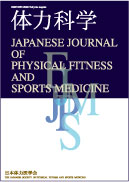Volume 58, Issue 1
Displaying 1-50 of 62 articles from this issue
-
2009Volume 58Issue 1 Pages 1-3
Published: February 01, 2009
Released on J-STAGE: May 01, 2009
Download PDF (73K)
-
2009Volume 58Issue 1 Pages 5-6
Published: February 01, 2009
Released on J-STAGE: May 01, 2009
Download PDF (87K)
-
2009Volume 58Issue 1 Pages 7
Published: February 01, 2009
Released on J-STAGE: May 01, 2009
Download PDF (31K)
-
2009Volume 58Issue 1 Pages 8-9
Published: February 01, 2009
Released on J-STAGE: May 01, 2009
Download PDF (27K)
-
2009Volume 58Issue 1 Pages 10
Published: February 01, 2009
Released on J-STAGE: May 01, 2009
Download PDF (16K)
-
2009Volume 58Issue 1 Pages 11
Published: February 01, 2009
Released on J-STAGE: May 01, 2009
Download PDF (21K)
-
2009Volume 58Issue 1 Pages 12
Published: February 01, 2009
Released on J-STAGE: May 01, 2009
Download PDF (24K)
-
2009Volume 58Issue 1 Pages 13
Published: February 01, 2009
Released on J-STAGE: May 01, 2009
Download PDF (29K) -
2009Volume 58Issue 1 Pages 14
Published: February 01, 2009
Released on J-STAGE: May 01, 2009
Download PDF (25K) -
2009Volume 58Issue 1 Pages 15
Published: February 01, 2009
Released on J-STAGE: May 01, 2009
Download PDF (22K) -
2009Volume 58Issue 1 Pages 16
Published: February 01, 2009
Released on J-STAGE: May 01, 2009
Download PDF (39K)
-
2009Volume 58Issue 1 Pages 17
Published: February 01, 2009
Released on J-STAGE: May 01, 2009
Download PDF (22K) -
2009Volume 58Issue 1 Pages 18
Published: February 01, 2009
Released on J-STAGE: May 01, 2009
Download PDF (35K) -
2009Volume 58Issue 1 Pages 19
Published: February 01, 2009
Released on J-STAGE: May 01, 2009
Download PDF (43K) -
2009Volume 58Issue 1 Pages 20
Published: February 01, 2009
Released on J-STAGE: May 01, 2009
Download PDF (39K) -
2009Volume 58Issue 1 Pages 21
Published: February 01, 2009
Released on J-STAGE: May 01, 2009
Download PDF (29K)
-
2009Volume 58Issue 1 Pages 22-23
Published: February 01, 2009
Released on J-STAGE: May 01, 2009
Download PDF (30K)
-
2009Volume 58Issue 1 Pages 24
Published: February 01, 2009
Released on J-STAGE: May 01, 2009
Download PDF (28K)
-
2009Volume 58Issue 1 Pages 25
Published: February 01, 2009
Released on J-STAGE: May 01, 2009
Download PDF (22K) -
2009Volume 58Issue 1 Pages 26
Published: February 01, 2009
Released on J-STAGE: May 01, 2009
Download PDF (19K) -
2009Volume 58Issue 1 Pages 27
Published: February 01, 2009
Released on J-STAGE: May 01, 2009
Download PDF (21K) -
2009Volume 58Issue 1 Pages 28
Published: February 01, 2009
Released on J-STAGE: May 01, 2009
Download PDF (26K) -
2009Volume 58Issue 1 Pages 29
Published: February 01, 2009
Released on J-STAGE: May 01, 2009
Download PDF (18K)
-
2009Volume 58Issue 1 Pages 30
Published: February 01, 2009
Released on J-STAGE: May 01, 2009
Download PDF (29K) -
2009Volume 58Issue 1 Pages 31
Published: February 01, 2009
Released on J-STAGE: May 01, 2009
Download PDF (21K) -
2009Volume 58Issue 1 Pages 32
Published: February 01, 2009
Released on J-STAGE: May 01, 2009
Download PDF (25K) -
2009Volume 58Issue 1 Pages 33
Published: February 01, 2009
Released on J-STAGE: May 01, 2009
Download PDF (19K)
-
2009Volume 58Issue 1 Pages 34_1
Published: February 01, 2009
Released on J-STAGE: May 01, 2009
Download PDF (19K) -
2009Volume 58Issue 1 Pages 34_2
Published: February 01, 2009
Released on J-STAGE: May 01, 2009
Download PDF (19K) -
2009Volume 58Issue 1 Pages 35_1
Published: February 01, 2009
Released on J-STAGE: May 01, 2009
Download PDF (23K) -
2009Volume 58Issue 1 Pages 35_2
Published: February 01, 2009
Released on J-STAGE: May 01, 2009
Download PDF (23K) -
2009Volume 58Issue 1 Pages 36_1
Published: February 01, 2009
Released on J-STAGE: May 01, 2009
Download PDF (23K) -
2009Volume 58Issue 1 Pages 36_2
Published: February 01, 2009
Released on J-STAGE: May 01, 2009
Download PDF (23K) -
2009Volume 58Issue 1 Pages 37_1
Published: February 01, 2009
Released on J-STAGE: May 01, 2009
Download PDF (25K) -
2009Volume 58Issue 1 Pages 37_2
Published: February 01, 2009
Released on J-STAGE: May 01, 2009
Download PDF (25K)
-
2009Volume 58Issue 1 Pages 38
Published: February 01, 2009
Released on J-STAGE: May 01, 2009
Download PDF (27K) -
2009Volume 58Issue 1 Pages 39
Published: February 01, 2009
Released on J-STAGE: May 01, 2009
Download PDF (24K) -
2009Volume 58Issue 1 Pages 40
Published: February 01, 2009
Released on J-STAGE: May 01, 2009
Download PDF (25K) -
2009Volume 58Issue 1 Pages 41
Published: February 01, 2009
Released on J-STAGE: May 01, 2009
Download PDF (22K)
-
2009Volume 58Issue 1 Pages 42-43
Published: February 01, 2009
Released on J-STAGE: May 01, 2009
Download PDF (33K)
-
2009Volume 58Issue 1 Pages 44
Published: February 01, 2009
Released on J-STAGE: May 01, 2009
Download PDF (23K)
-
2009Volume 58Issue 1 Pages 45
Published: February 01, 2009
Released on J-STAGE: May 01, 2009
Download PDF (26K) -
2009Volume 58Issue 1 Pages 46
Published: February 01, 2009
Released on J-STAGE: May 01, 2009
Download PDF (35K)
-
2009Volume 58Issue 1 Pages 47-48
Published: February 01, 2009
Released on J-STAGE: May 01, 2009
Download PDF (96K) -
2009Volume 58Issue 1 Pages 49
Published: February 01, 2009
Released on J-STAGE: May 01, 2009
Download PDF (64K) -
2009Volume 58Issue 1 Pages 50
Published: February 01, 2009
Released on J-STAGE: May 01, 2009
Download PDF (71K) -
2009Volume 58Issue 1 Pages 51
Published: February 01, 2009
Released on J-STAGE: May 01, 2009
Download PDF (67K) -
2009Volume 58Issue 1 Pages 52
Published: February 01, 2009
Released on J-STAGE: May 01, 2009
Download PDF (85K) -
2009Volume 58Issue 1 Pages 53
Published: February 01, 2009
Released on J-STAGE: May 01, 2009
Download PDF (60K)
Original
-
2009Volume 58Issue 1 Pages 55-62
Published: February 01, 2009
Released on J-STAGE: May 01, 2009
Download PDF (242K)
